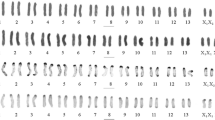Abstract
The diploid chromosome number of 13 species belonging to the family Araneidae (Araneae) ranges between 16 and 25. The ♂ sex-determining mechanism seems to be X1X2X3X4O in one species; X1X2X3O in three species and X1X2O in the remaining 9 species. The X1X2X3X4O, ♂ sex-determining mechanism is reported for the first time in spiders. All the chromosomes are with terminal centromeres. C-band preparations in 5 species suggest procentric localization of constitutive heterochromatin in all the chromosomes, though distally located C-band positive blocks are also visible in a few chromosomes.
It is suggested that chromosomal evolution in this family has taken place by gradual reduction in diploid number through tandem/centric fusion followed by pericentric inversion in autosomes and nondisjunction/duplication of one X, with subsequent loss of homology in sex chromosomes.
Similar content being viewed by others
References
Berry, E. R., 1906. The accessory chromosome in Epeira. Biol. Bull. 11: 193–201.
Bole-Gowda, B. N., 1953. Chromosome study of fifteen species of spiders (Abstract). Proc. 40th Ind. Sci. Cong., Lucknow 3: 179–180.
Bole-Gowda, B. N., 1958. A study of the chromosomes during meiosis in twenty-two species of Indian Spiders. Proc. Zool. Soc. Bengal. 11: 69–108.
Brum-Zorrilla, N. & Cazanave, A. M., 1974. Heterochromatin localization in the chromosomes of Lycosa malitosa (Arachnida). Experientia 30: 94–95.
Comstock, J. H., 1948. The Spider Book. Comstock, New York, USA.
Diaz, M. O. & Saez, F. A., 1966. Karyotypes of South-American Araneida. Mem. Inst. Butantan Simp. Internac. 33: 153–154.
Dyal, S., 1935. Spiders of Lahore. Bull. Dept. Zool. Panjab Univ. 1: 119–252.
Hackman, W., 1948. Chromosomenstudien an Araneen mit besonderer Berücksichtigung der Geschlechtschromosomen. Acta zool. Fenn. 54: 1–101.
Maddison, W. P., 1982. XXXY Sex chromosomes in males of the jumping spider genus Pellenes (Araneae: Salticidae). Chromosoma 85: 23–37.
Matsumoto, S., 1977. An observation of somatic chromosomes from spider embryo-cells. Acta arachnol. 27: 167–172.
Mittal, O. P., 1960. Chromosome number and sex mechanism in twenty species of the Indian spiders. Res. Bull. (N.S.) Panjab Univ. 11: 245–247.
Mittal, O. P., 1961. Chromosome number and sex mechanism in twenty-one species of the Indian spiders. Res. Bull. (N.S.) Panjab Univ. 12 (3–4): 271–273.
Mittal, O. P., 1966. Karyological studies on the Indian spiders VI. Chromosome number and sex-determining mechanism in the family Araneidae. Res. Bull. (N.S.) Panjab Univ. 17 (3–4): 335–351.
Patau, K., 1948. X-segregation and heterochromasy in the spider Aranea reaumuri. Heredity 2: 77–100.
Pocock, R. I., 1900. Fauna of British India. Arachnida. Taylor & Francis, London: 153–279.
Postiglioni, A. & Brum-Zorrilla, N., 1981. Karyological studies on Uruguayan spiders II. Sex chromosomes in spiders of the genus Lycosa (Araneae: Lycosidae). Genetica 56: 47–53.
Rower, C. F., 1942. Katalog der Araneae. 1. R. Friedlander, Berlin, Germany.
Sharma, G. P., Jande, S. S. & Tandon, K. K., 1959. Cytological studies on the Indian spiders IV. Selenops radiatus Latreille (Selenopidae) and Leucauge decorata (Blackwall) (Tetragnathidae) with special reference to XXXO type of male sex-determining mechanism. Res. Bull. (N.S.) Panjab Univ. 10(1): 73–80.
Sharma, G. P., Tandon, K. K. & Grewal, M. S., 1960. Cytological studies on the Indian spiders V. Chromosome complement and male meiosis in Hersilia savignyi Lucas (Hersiliidae), Larinia sp. (Argiopidae), Tetragnatha sp. (Tetragnathidae), Oxyopes ryvesii Pocock and Oxyopes sp. (Oxyopidae). Res. Bull. (N.S.) Panjab Univ. 11 (3–4): 201–206.
Sokolov, I. I., 1960. Studies on nuclear structure in spiders (Araneina) I. Karyological peculiarities in spermatogenesis. Vopr. Cytol. i Protistol. 160–186.
Symner, A. T., 1972. A simple technique for demonstrating centromeric heterochromatin. Expl Cell Res. 75: 304–305.
Suzuki, S., 1951. Cytological studies in spiders I. A comparative study of the chromosomes in the family Argiopidae. J. Sci. Hiroshima Univ., B 12: 67–98.
Suzuki, S., 1954. Cytological studies in spiders III. Studies on the chromosomes of fifty-seven species of spiders belonging to seventeen families, with general considerations on chromosomal evolution. J. Sci. Hiroshima Univ., B 15: 23–136.
Tikader, B. K., 1982. Fauna of India. Spiders Vol. II. Publn. Zoological Survey of India, Calcutta.
White, M. J. D., 1973. Animal cytology and evolution. 3rd Ed., Cambridge University Press.
Author information
Authors and Affiliations
Rights and permissions
About this article
Cite this article
Datta, S.N., Chatterjee, K. Chromosomes and sex determination in 13 araneid spiders of North-Eastern India. Genetica 76, 91–99 (1988). https://doi.org/10.1007/BF00058807
Received:
Accepted:
Issue Date:
DOI: https://doi.org/10.1007/BF00058807




